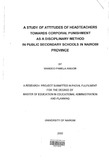| dc.contributor.author | Wandeo, Pamela A | |
| dc.date.accessioned | 2013-05-02T08:56:55Z | |
| dc.date.available | 2013-05-02T08:56:55Z | |
| dc.date.issued | 2002 | |
| dc.identifier.citation | M.ED (Educational Administration and Planning) Thesis 2002 | en |
| dc.identifier.uri | http://erepository.uonbi.ac.ke:8080/xmlui/handle/123456789/18312 | |
| dc.description | Master of Education Thesis | en |
| dc.description.abstract | Teachers, to a large extent have assumed the role of parents. This is
because teachers spend a greater part of their day with the children as
compared to the time children spend with their parent during their
school going age. The issue of discipline in most cases has been left
to the teachers.
Many secondary school headteachers have handled matters related to
student discipline in various ways. Corporal punishment has been
used as a method of discipline in various schools until the withdrawal
by the Ministry of Education last year (2001). The purpose of this study
was to examine the attitude of the headteachers in the use of corporal
punishment as a disciplinary method in public secondary schools in
Nairobi province. The study also sought to determine the kind of
discipline problems experienced in public secondary schools in Nairobi
province, the discipline problems which were being handled by using
corporal punishment. The study also sought to find out whether those
headteachers who were caned when they were students have a
different attitude towards the use of corporal punishment compared to
those who were never caned.
The study further sought the headteachers' attitude towards the
effectiveness of corporal punishment. Lastly it sought to study whether
corporal punishment should be reinstated.
The literature review in this study was organised under the following
sub-headings: the concept of attitude, general overview of discipline in
schools, headteachers and discipline in schools, nature of indiscipline
in schools, the causes of indiscipline in schools, the positive attitude
towards the use of corporal punishment and the negative attitude
towards the use of corporal punishment
From the literature review, an integrated approach to discipline and
conceptual framework were designed.
The study was ex-post facto in design and the, targeted population
consisted of headteachers in public secondary schools in Nairobi
Province. In this study, one set of questionnaires was developed by
the researcher as the research instrument. The questionnaire was
divided into two parts. Part one consisted of nine (9) short questions
on school and demographic variables. Part two of the questionnaire
consisted of two sections A and B. The questions on part Bwere open
ended.
The supervisor validated the research instrument. All public secondary
school of Nairobi province were used.. Five of them were used for
piloting while the rest were used for the study. All headteachers were
given questionnaires to complete. The sample consisted of 45
headteachers of which 37 completed and returned their questionnaires.
The Analysis of Variance (ANOVA) was used to test the hypotheses
The following are the findings of the research study:
1. All public secondary schools in Nairobi Province experienced
discipline problems among students with the most frequency
occurring being noisemaking in class and theft cases.
2. Corporal punishment was commonly used in solving discipline
problems such as noise making and late coming to school.
3. There are very few headteachers with special training in guidance
and counselling other than child psychology that they learnt
during their training to be teachers.
4. No significant relationship existed between the age of the
headteacher and their attitude towards the use of corporal
punishment as a disciplinary method.
5. No significant relationship existed between the gender of the
headteachers and the headteachers' attitude towards the use of
corporal ~unishment as a disciplinary method.
6 No significant relationship existed between the headteachers'
professional grade and the headteachers' attitude towards the
use of corporal punishment as a disciplinary method.
7. No significant relationship existed between the administrative
experience of the headteachers and the headteachers' attitude
towards the use of corporal punishment as a disciplinary method.
8. No significant relationship existed between the headteachers'
special training in guidance and counselling and the headteachers attitude towards corporal punishment as
a disciplinary method.
9. No significant relationship existed between the kind of discipline
problems experienced in secondary schools and the
headteachers' attitude towards the use of corporal punishment as
a disciplinary method.
The recommendations of the study are as follows:
1. The headteachers be encouraged to use alternative methods of
behaviour modification such as dialogue with students.
2. More headteachers be trained in Guidance and Counselling.
3. Disciplinary committees be set up in all schools by the Teachers
Service Commission to help in controlling indiscipline in schools.
4. Corporal punishment is not popular and therefore should not be
reinstated.
The following research areas are suggested for further research:
1. Replication of this study using an interview schedule as the
research instrument with headteachers.
2. A comparative study on the attitudes of the head teaches on
the use of corporal 'punishment in public secondary schools in
rural and urban set-ups
3. A study of the effects of the withdrawal of corporal punishment
in public secondary schools in rural schools | en |
| dc.description.sponsorship | University of Nairobi | en |
| dc.language.iso | en | en |
| dc.title | A study of attitudes of Headteachers towards corporal punishment as a disciplinary method in public secondary schools in Nairobi province | en |
| dc.type | Thesis | en |
| local.publisher | College of Education and External Studies, University of Nairobi, | en |

